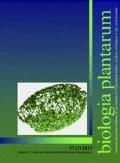Abstract
Trehalose was supplied to wheat (Triticum aestivum L.) seedlings just before a high temperature (40 °C) treatment and some physiological parameters were measured during the heat stress and recovery. The application of trehalose decreased the net photosynthetic rate (PN) of wheat seedlings under the heat stress, but to a small extent increased the dry mass (DM) and leaf water content (LWC) after recovery from the heat stress. The trehalose-induced decrease in PN under the heat stress was not associated with a stomatal response. The heat stress slightly decreased the maximal efficiency of photosystem II (PS II) photochemistry (the variable to maximum chlorophyll a fluorescence ratio, Fv/Fm) similarly in the trehalose treated or non-treated plants. Under the heat stress, the actual efficiency of PS II photochemistry (ΦPSII) and the efficiency of excitation energy capture by open reaction centers (Fv′/Fm′) were lower in the trehalose-pretreated seedlings, whereas they were higher after the recovery. The patterns of changes in nonphotochemical quenching (NPQ) were contrary to those of ϕPS II and Fv′/Fm′. The chlorophyll content was lower, whereas the β-carotene content and the degree of de-epoxidation (DEPS) of xanthophyll cycle pigments were higher in the trehalose-pretreated wheat seedlings under the heat stress. These results suggest that exogenous trehalose partially promotes recovery of wheat by the increase of NPQ, β-carotene content, and DEPS.
Abbreviations
- A:
-
antheraxanthin
- Car:
-
β-carotene
- Chl:
-
chlorophyll
- DEPS:
-
degree of deepoxidation [(A+Z)/(V+A+Z)]
- Fv/Fm :
-
variable to maximum Chl fluorescence ratio in dark adapted leaves (the maximal efficiency of PS II photochemistry)
- Fv′/Fm′:
-
variable to maximum Chl fluorescence ratio under steady-state conditions (the efficiency of excitation energy capture by open reaction centers)
- gs :
-
stomatal conductance
- LWC:
-
leaf water content
- NPQ:
-
non-photochemical quenching
- PN :
-
net photosynthetic rate
- PS:
-
photosystem
- qp :
-
photochemical quenching
- V:
-
violaxanthin
- Z:
-
zeaxanthin
- ϕPS II :
-
the actual efficiency of PS II photochemistry
References
Bae, H., Herman, E., Bailey, B., Bae, H.J., Sicher, R.: Exogenous trehalose alters Arabidopsis transcripts involved in cell wall modification, abiotic stress, nitrogen metabolism, and plant defense — Physiol. Plant. 125: 114–126, 2005.
Björkman, O., Demmig, B.: Photon yield of O2 evolution and chlorophyll fluorescence characteristics at 77 K among vascular plants of diverse origins — Planta 170: 489–504, 1987.
Boyer J.: Plant productivity and the environment — Science 218: 443–448, 1982.
Brestic, M., Zivca, M.: PSII fluorescence techniques for measurement of drought and high temperature stress signal in crop plants: protocols and applications — In: Rout, G.R., Das, A.B. (ed.): Molecular Stress Physiology of Plants. Pp. 87–131. Springer, Bhubaneswar 2013.
Gao, J., Wang, N., Xu, S.S., Li, Y., Wang, Y., Wang, G.X.: Exogenous application of trehalose induced H2O2 production and stomatal clousure in Vicia faba — Biol. Plant. 57: 380–384, 2013.
Garg, A.K., Kim, J.K., Owens, T.G., Ranwala, A.P., Choi, Y.D., Kochian, L.V., Wu, R.J.: Trehalose accumulation in rice plants confers high tolerance levels to different abiotic stresses — Proc. nat. Acad. Sci. USA 99: 15898–15903, 2002.
Genty, B., Briantais, J.M., Baker, N.R.: The relationship between the quantum yield of photosynthetic electron transport and quenching of chlorophyll fluorescence — Biochim. biophys. Acta 99: 87–92, 1989.
Gilmore, A.M.: Mechanistic aspects of xanthophyll cycledependent photoprotection in higher plant chloroplasts and leaves — Physiol. Plant. 99: 197–209, 1997.
Havaux, M.: Characterization of thermal damage to the photosynthetic electron transport system in potato leaves — Plant Sci. 94: 19–33, 1993.
Iordachescu, M., Imai, R.: Trehalose biosynthesis in response to abiotic stresses — J. integr. Plant Biol. 50: 1223–1229, 2008.
Jin, E.S., Yokthongwattana, K., Polle, J.E.W., Melis, A.: Role of the reversible xanthophyll cycle in the photosystem II damage and repair cycle in Dunaliella salina — Plant Physiol. 132: 352–364, 2003.
Kaplan, F., Kopka, J., Haskell, D.W., Zhao, W., Schiller, K.C., Gatzke, N., Sung, D.Y., Guy, C.L.: Exploring the temperature-stress metabolome of Arabidopsis. —Plant Physiol. 136: 4159–4168, 2004.
Karim, S., Aronsson, H., Ericson, H., Pirhonen, M., Leyman, B., Welin, B., Mäntylä, E., Palva, E.T., Dijck, P.V., Holmström K.O.: Improved drought tolerance without undesired side effects in transgenic plants producing trehalose — Plant mol. Biol. 64: 371–386, 2007.
López-Gómez, M., Lluch, C.: Trehalose and abiotic stress tolerance — In: Ahmad, P., Prasad, M.N.V. (ed.): Abiotic Stress Responses in Plants: Metabolism, Productivity and Sustainability. Pp. 253–265. Springer-Verlag, New York 2012.
Luo, Y., Li, F., Wang, G.P., Yang, X.H., Wang, W.: Exogenously-supplied trehalose protects thylakoid membranes of winter wheat from heat-induced damage — Biol. Plant. 54: 495–501, 2010.
Maxwell, K., Johnson, G.N.: Chlorophyll fluorescence — a practical guide — J. exp. B. 51: 659–668, 2000.
Melis, A.: Photosystem II damage and repair cycle in chloroplast: what modulates the rate of photodamage in vivo? — Trends Plant Sci. 4: 130–135, 1999.
Nounjana, N., Nghiab, P.T., Theerakulpisuta, P.: Exogenous proline and trehalose promote recovery of rice seedlings from salt-stress and differentially modulate antioxidant enzymes and expression of related genes — J. Plant Physiol. 169: 596–604, 2012.
Peñuelas, J., Munné-Bosch, S.: Isoprenoids: an evolutionary pool for photoprotection — Trends Plant Sci. 10: 166–169, 2005.
Zhao, S.J., Meng, Q.W., Xu, C.C., Han, H.Y., Zou, Q.: Analysis of the xanthophyll cycle components in plant tissues by high performance liquid chromatography — Plant Physiol. Commun. 31: 438–442, 1995.
Author information
Authors and Affiliations
Corresponding author
Additional information
Acknowledgements: This work was supported by the Natural Science Foundation of China (No. 31200301), and the Fund of State Key Laboratory of Crop Biology (No. 2013KF01).
Rights and permissions
About this article
Cite this article
Luo, Y., Gao, Y.M., Wang, W. et al. Application of trehalose ameliorates heat stress and promotes recovery of winter wheat seedlings. Biol Plant 58, 395–398 (2014). https://doi.org/10.1007/s10535-014-0397-6
Received:
Revised:
Accepted:
Published:
Issue Date:
DOI: https://doi.org/10.1007/s10535-014-0397-6

